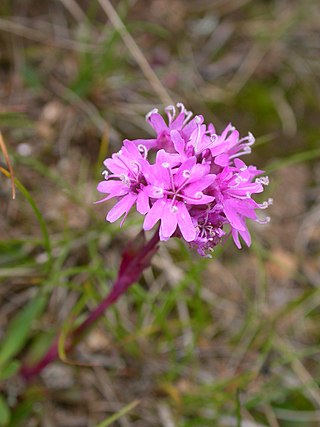This article gives an overview of the plant communities formed by vegetation of open habitats in the British National Vegetation Classification system.

Silene nutans is a flowering plant in the genus Silene, most commonly known as Nottingham catchfly.

Lambert's Castle is an Iron Age hillfort in the county of Dorset in southwest England. Since 1981 it has been designated as a Site of Special Scientific Interest (SSSI) on account of its geology, archaeology and ecology. The hillfort is designated a scheduled monument together with a bowl barrow, the sites of a post-medieval fair and a telegraph station. The site was on the Heritage at Risk Register but was removed in 2022 as a result of the Hillforts and Habitats Project.
British NVC community MG1, Arrhenatherum elatius grassland, is one of the mesotrophic grassland communities in the British National Vegetation Classification system. This type of plant community was named in 1919 as Arrhenatheretum elatiorisBr.-Bl.. It is a very widespread community throughout the British lowlands of England, Wales and southern and eastern Scotland.
NVC community CG2 is one of the calcicolous grassland communities in the British National Vegetation Classification system. It is one of three short-sward communities associated with heavy grazing, within the lowland calcicolous grassland group, and is regarded as "typical" chalk grassland.
British NVC community OV41 is one of the open habitat communities in the British National Vegetation Classification system. It is one of six communities of crevice, scree and spoil vegetation.
British NVC community OV39 is one of the open habitat communities in the British National Vegetation Classification system. It is one of six communities of crevice, scree and spoil vegetation.
British NVC community MC4 is one of the maritime cliff communities in the British National Vegetation Classification system. It is one of five communities categorised as maritime cliff crevice and ledge communities.
British NVC community MC5 is one of the maritime cliff communities in the British National Vegetation Classification system. It is one of five communities categorised as maritime cliff crevice and ledge communities.

Briza media is a perennial grass in the family Poaceae and is a species of the genus Briza.

Purple moor grass and rush pastures is a type of Biodiversity Action Plan habitat in the UK. It occurs on poorly drained neutral and acidic soils of the lowlands and upland fringe. It is found in the South West of England, especially in Devon.

Silene suecica is a species of plant in the family Caryophyllaceae. Its common name is red Alpine catchfly and its natural habitat is the mountains of Norway and Sweden but it is sometimes found near the coasts and it is also found in the Alps and the Pyrenees, Greenland and North America.

Briza minor is a species of grass known by the common names lesser quaking-grass or little quakinggrass. It is native to the Mediterranean Basin, and it is known elsewhere, including much of North America, as an introduced species. It is an annual grass producing narrow clumps of erect stems up to 50 centimeters tall. The inflorescence bears several small cone-shaped spikelets, each hanging on a pedicel.

Cassop Vale is a Site of Special Scientific Interest in the Durham City district of County Durham, England. It lies between the villages of Bowburn and Cassop, 7 km south-east of the centre of Durham..
Raisby Hill Grassland is a Site of Special Scientific Interest in east County Durham, England. It lies just over 1 km east of the village of Coxhoe.

Silene gallica is a species of flowering plant in the family Caryophyllaceae known by several common names, including common catchfly, small-flowered catchfly, and windmill pink. It is native to Eurasia and North Africa, but it can be found throughout much of the temperate world as a common roadside weed.
British NVC community OV1 is one of the open habitat communities in the British National Vegetation Classification system. It is one of six arable weed and track-side communities of light, less-fertile acid soils.
British NVC community OV6 is one of the open habitat communities in the British National Vegetation Classification system. It is one of six arable weed and track-side communities of light, less-fertile acid soils.
British NVC community OV16 is one of the open habitat communities in the British National Vegetation Classification system. It is one of two arable weed communities of light lime-rich soils.

Silene regia is a species of flowering plant in the family Caryophyllaceae known by the common name royal catchfly. It is native to the central United States. A perennial herb, it grows from a fleshy taproot and has several erect stems growing up to 1.6 meters tall. The leaves are lance-shaped to oval and up to 12 centimeters (4.7 in) long, becoming smaller farther up the stem. The inflorescence is an array of many flowers at the top of the stem. The elongate tubular calyx of sepals is up to 2.5 centimeters (0.98 in) long and has 10 longitudinal veins. The lobes of the bright red corolla are 1 to 2 centimeters long.








